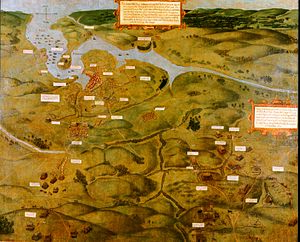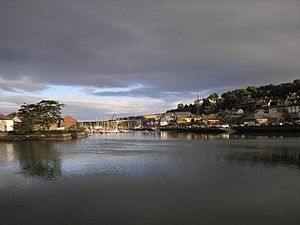Siege of Kinsale facts for kids
Quick facts for kids Siege of Kinsale |
|||||||
|---|---|---|---|---|---|---|---|
| Part of the Nine Years' War | |||||||
 Map of the siege of Kinsale, 1602 |
|||||||
|
|||||||
| Belligerents | |||||||
| Commanders and leaders | |||||||
| Strength | |||||||
| 11,800 infantry 857 cavalry |
Irish alliance 6,000 Spanish 3,500 |
||||||
| Casualties and losses | |||||||
| Unknown casualties 6,000 deserted, sick or dead to disease |
Irish alliance 1,200 killed, wounded or captured (many later executed) Spanish 100 killed or wounded, 3,400 prisoners |
||||||
The Siege of Kinsale (also known as the Battle of Kinsale) was a very important battle in Irish history. It happened in October 1601 near the town of Kinsale in Ireland. This battle was the final major fight in England's effort to take full control of Gaelic Ireland.
It took place near the end of Queen Elizabeth I's reign. It was also the most important part of the Nine Years' War. This war was a big rebellion led by Irish lords like Hugh O'Neill and Hugh Roe O'Donnell against English rule.
Because Spain got involved, the battle was also part of the wider Anglo-Spanish War. This was a conflict between Protestant England and Catholic Spain.
Contents
Why the Battle Happened
For a long time, the English Crown had claimed Ireland as its own. But England only truly controlled a small area around Dublin called the Pale. Most of Ireland was still ruled by powerful Irish lords.
The English kings and queens, starting with Henry VIII, wanted to control all of Ireland. They tried to do this by taking over land and sending English settlers.
In 1594, a powerful Irish leader named Hugh O'Neill started a rebellion in Ulster. Other Irish lords, like Hugh Roe O'Donnell, joined him. From 1593 to 1599, the Irish rebels won many battles. They took control of most of the island from the English. By the end of 1599, the English only held onto walled towns and military bases.
Spain's Help for Ireland
After Spain's attempts to invade England failed in 1588, King Philip II decided to help the Irish rebels. He hoped that by keeping England busy in Ireland, it would weaken England's support for the Netherlands. The Netherlands was fighting its own long war against Spanish rule. Also, a base in Ireland could help Spanish ships attack English and Dutch trade ships.
Philip II sent two more fleets to help the Irish in 1596 and 1597. But both of these fleets were destroyed by bad storms.
After Philip II died, his son Philip III continued to support the Irish rebels. In 1601, Philip III sent a Spanish force of 6,000 soldiers to Ireland. They also brought many weapons and ammunition. Bad weather caused some ships to turn back. But about 4,000 Spanish soldiers landed at Kinsale, south of Cork, on October 2, 1601. Another small group landed nearby at Baltimore. The Spanish quickly built defenses to protect themselves from the English army.
The Spanish army had taken Kinsale, but they couldn't expand their control into the area around it. This made them easy targets for an English siege. When the English leader, Lord Mountjoy, heard about the Spanish landing, he quickly gathered his troops. He marched them to Kinsale to surround the Spanish.
The Siege Begins
On October 2, Lord Mountjoy began his siege of Kinsale. More English soldiers arrived, bringing his army to about 12,000 men. This included a large group led by the Irish nobleman Donogh O'Brien, 4th Earl of Thomond. However, many of these soldiers were Irish recruits. They were not used to fighting in a siege, especially in winter. Many got sick, leaving only about 7,500 soldiers able to fight.
Meanwhile, the Irish leaders, O'Neill and O'Donnell, had a problem. The Spanish had landed far from their lands in the north of Ireland. To help the Spanish, they had to march their armies through areas where people might not support them. They waited for weeks as autumn turned into a very wet and stormy winter. The Spanish soldiers trapped in Kinsale started to suffer from a lack of food and supplies.
O'Neill knew that if the Spanish lost, he would not get more help. So, he decided to march south to help them. He knew this meant risking a big battle instead of his usual hit-and-run tactics. O'Neill and O'Donnell set out on a 300-mile winter march. They marched separately to make it easier to find supplies. O'Neill had 2,500 foot soldiers and 500 horsemen. O'Donnell had 1,500 foot soldiers and 300 horsemen. After a difficult march in bad weather, the two forces met up near Kinsale.
Lord Mountjoy's army could not completely surround Kinsale. But they took control of higher ground and fired cannons at the Spanish. The English navy, led by Admiral Richard Leveson, arrived with ten ships. They blocked Kinsale from the sea, stopping any supplies from reaching the Spanish. English cavalry rode through the countryside, destroying food and crops.
O'Neill and O'Donnell were worried about leaving Ulster open to attack. They also had trouble getting enough supplies for their troops. But their march south did cut off English supply lines. By December, the English army besieging Kinsale was also suffering. Many soldiers were dying from sickness like dysentery and fever.
More Spanish soldiers arrived at Castlehaven. On December 24, 1601, the Irish and Spanish armies moved into position near the English camp. Around midnight, the Irish, led by O'Neill and O'Donnell, marched towards a ridge overlooking the English camp. English scouts saw them moving in the dark. Lord Mountjoy quickly prepared his troops for battle. His army was much smaller now due to sickness and desertion.
The Battle of Kinsale
The Irish force that arrived was over 6,000 men. It included soldiers from Leinster, Munster, and a small group of Spanish foot soldiers. The English cavalry, though smaller in number, were ready.
First Moves
The English commander, Wingfield, saw the Irish forces approaching. Mountjoy decided to fight right away. He ordered more English soldiers to come up and support Wingfield. O'Neill saw the English advancing and ordered his forces to pull back to a river. Wingfield pursued them.
The Irish forces crossed a river and a muddy area, then formed up on solid ground. O'Neill likely wanted the muddy ground to protect his soldiers from the English horsemen. But by pulling back, he gave the advantage to Mountjoy.
Irish Retreat
The English cavalry, led by Wingfield, charged the Irish. The Irish tried to hold their ground, but they were not used to fighting in tight formations like the Spanish. The English cavalry managed to get around the Irish main line. This caused the Irish skirmishers (soldiers who fight in small groups) to fall back.
The English cavalry charged again. O'Neill's cavalry, made up of Irish chiefs and gentlemen, tried to counter-attack. But the English horsemen were more disciplined and better armed. English soldiers fired a volley of shots, causing the Irish cavalry to break and flee. They ran straight back into O'Neill's main army, causing confusion and making part of it run away.
Seeing this, the English cavalry charged into the disorganized Irish army. O'Neill's men were completely defeated and chased by the English horsemen. Many Irish soldiers fled back to Ulster.
Spanish Surrender
O'Donnell's part of the Irish army arrived late and did not get involved in the main fight. Seeing O'Neill's defeat, O'Donnell also retreated. O'Neill's decision to pull back at the start of the battle cost him dearly. His troops were not trained to stand firm in a big battle like a professional army.
The Spanish soldiers, seeing the Irish army defeated and fleeing, found themselves alone. They tried to hold their ground on a small hill. But they were surrounded by the English cavalry and overwhelmed. Many Spanish soldiers were killed or captured. The Spanish commander, Juan del Águila, realized his situation was hopeless without the Irish lords' help.
The English continued to surround Kinsale. Del Águila surrendered the town to Mountjoy. The Spanish were allowed to sail back to Spain with honor. They did not know that another Spanish force was on its way. When that force heard about the surrender, they turned back to Spain.
What Happened Next
The Battle of Kinsale showed that the Irish light cavalry was no match for the English cavalry. The Irish infantry was also not well-trained for a big, open battle against a professional army. The English had always wanted to fight the Irish on open ground. They easily defeated an army three times their size.
This defeat ended Spain's help for Ireland. It also greatly weakened the Irish resistance. The Ulster forces went back home. After two more years of fighting, the last of them surrendered in 1603, just after Queen Elizabeth died. The next year, England and Spain made peace with the Treaty of London.
O'Donnell sailed to Spain but died a few months later. Some say he was poisoned. O'Neill returned to Ulster and kept fighting for a short time. But his reputation for being unbeatable was broken. He surrendered in March 1603 and was given good terms. Four years later, he decided to go to Spain. O'Neill and many other Irish chiefs left Ireland in what is called the "Flight of the Earls". They hoped to raise an army and return to fight the English. But the lands they left behind were soon given to English and Scottish settlers in the Plantation of Ulster. They were never able to return.
The English government used this chance to take most of the land in Ulster. They brought in Scottish and English settlers to farm it. The English had finally achieved their goal of destroying the old Irish way of life and the clan system.
The Battle of Kinsale had a huge impact on Irish culture and way of life. The old Gaelic system was finally broken. As the Irish aristocracy left for Europe, the English took full control.
See also
 In Spanish: Batalla de Kinsale para niños
In Spanish: Batalla de Kinsale para niños
- Nine Years' War (Ireland)
- Irish battles
- History of Ireland (1536–1691)




